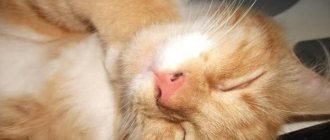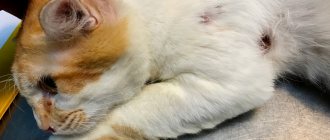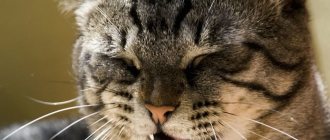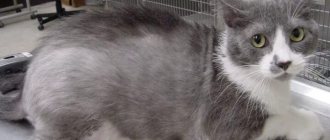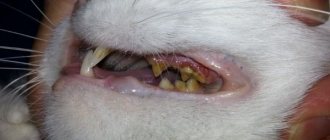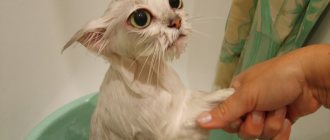Sterilizing an animal is an operation. Having agreed to it, you should be aware of the first signs of complications. This way you can identify them in time and take appropriate measures. The manifestation of consequences after sterilization of a cat is not a frequent occurrence, but the risk of occurrence is always present. Following the rules of nutrition and postoperative care will avoid many complications.
Signs of complications
The main signs of complications after sterilization are:
- if the suture bleeds after surgery (do not confuse it with ichor)
- if urination is bloody and has an uncharacteristic color
- if a cat does not go to the toilet for 3 days after sterilization
- if the temperature continues to stay at 39.5 C on day 5
- if the pet turns out to eat food for more than 5 days
- if your cat has diarrhea or constipation after sterilization
- if after 5 days, the postoperative suture remains wet, swollen, red, signs of rotting appear, or the discrepancy is more than 1 mm
- if there is discharge from the loop (vagina) of the cat
- if the pet is lethargic all the time, does not react to anything and sleeps a lot
- if the animal behaves restlessly and screams
If any of the signs are detected, you should seek help from a qualified specialist.
From the eyes
The discharge of reddish-brown clots from the animal's eyes indicates an ophthalmic disease. There are a number of side signs that can be used to determine that a cat is sick:
- eye rubbing;
- depressed behavior;
- lack of appetite.
A possible cause of the pathology may be a violation of the patency of the lacrimal canals due to a foreign object or tumor entering the eye. In this case, an examination by an ophthalmologist is necessary.
Bloody discharge from the eyes in cats can also be caused by heat or sunburn . In this case, before providing professional assistance, you can drip the animal’s eyes with a solution of sodium sulfacyl, after rinsing them for 5-10 minutes.
In cats, spotting can be either normal or a sign of serious illness. In the first case, they accompany normal physiological processes, such as estrus or cleansing of the uterine cavity after childbirth. But if the discharge appears at the wrong time, causes discomfort to your pet and has a foul odor, you should consult a veterinarian as soon as possible. If this is not done, the animal may die.
So, how to distinguish normal discharge from pathological ones and how to treat a cat?
The cat is lethargic and sleeps a lot.
Constant drowsiness and lethargy may prevail during the first few days. After this, the animal should return to normal. If a cat after sterilization continues to sleep a lot, lethargic and inert, and even more so if trembling (convulsions) or vomiting appears, this indicates a weakened body. Contact your doctor, he will prescribe appropriate stimulants.
Treatment
Before starting to treat the animal, the doctor finds out the root cause of the discharge. This will require the following examinations:
- initial examination of the animal, careful palpation of the abdominal area;
- general and biochemical blood test, laboratory urine test;
- Ultrasound of internal organs;
- examination of the uterus using a colposcope;
- study of secretions;
- bacterial culture to identify the pathogen;
- biopsy of the mucous membranes of the genital organs.
Based on the research results, the doctor makes a diagnosis and prescribes the necessary medications and procedures.
Depending on the reason for the bleeding, the cat is prescribed the following treatment:
- Anti-shock therapy is carried out using painkillers.
- If your cat is bleeding heavily, a blood transfusion may be required.
- If the bleeding is caused by low blood clotting, then corrective therapy is prescribed.
- For pathologies such as tumors or endometritis, surgery followed by chemotherapy is indicated to reduce the risk of relapse.
- The animal is prescribed antibiotics when the disease is caused by pathogenic microorganisms.
All medications and their dosage can be prescribed and adjusted only by a veterinarian. Self-medication will not only not bring a positive result, but can also lead to the premature death of your pet.
Purulent discharge from a cat's noose
Purulent discharge from a cat’s loop, just like brown discharge, indicates a disorder. The presence of purulent discharge from the animal’s vagina may indicate the presence of diseases such as:
- neoplasia of the urogenital tract;
- unhealthy position of the ureter;
- trauma to the vagina or the presence of a foreign body in it;
- urogenital infections;
- pyometra and others.
Treatment of various discharges in a cat occurs by prescribing antibiotics, chemotherapy, and restorative therapy. In many cases, surgery is required to remove the tumor or correct organ defects.
In any case, the sooner you bring your pet to our clinic, the sooner the veterinarian will be able to conduct the necessary additional examinations and prescribe a course of effective treatment.
Prices for appointments in our clinics
| Name of veterinary services | Unit | Price, rub |
| ⭐ Initial appointment | 1 animal | 400 |
| ⭐ Repeated appointment | 1 animal | 200 |
| Primary reception of ornamental, exotic animals, birds and reptiles | 1 animal | 1000 |
| Consultation without an animal | — | 500 |
| Consultation with a doctor based on test results | 1 PC. | 400 |
CLINIC REGISTRATION
HOME CALL


